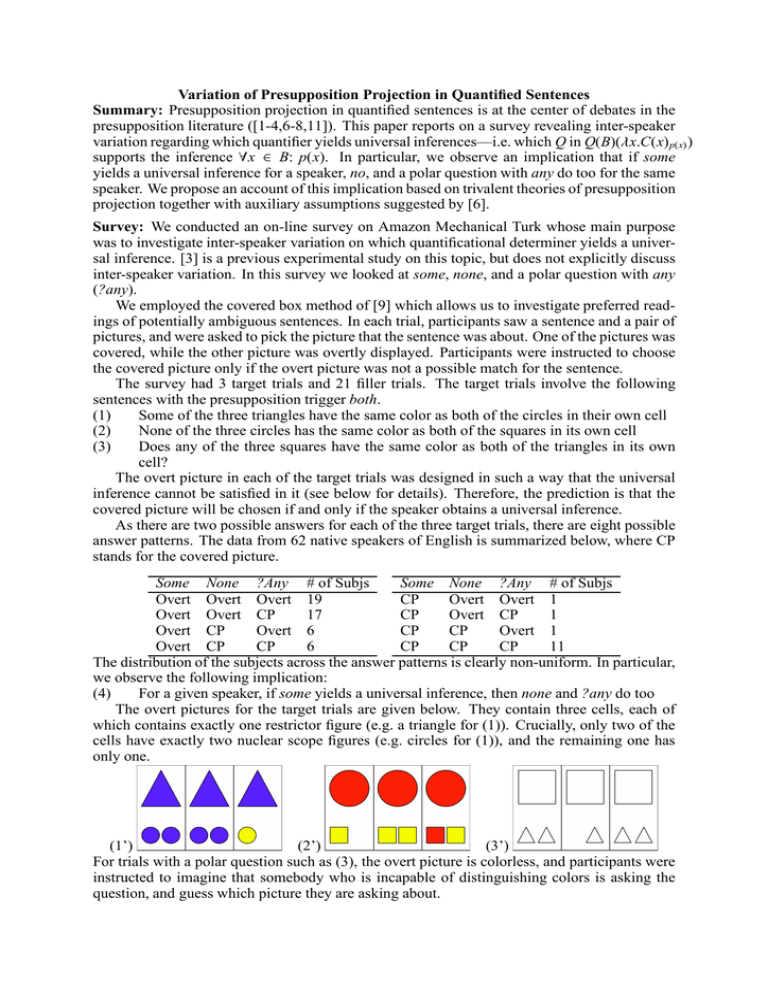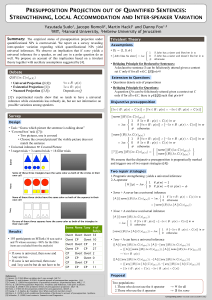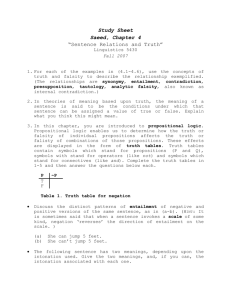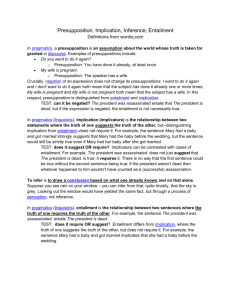Variation of Presupposition Projection in Quantified Sentences Summary: Q
advertisement

Variation of Presupposition Projection in Quantified Sentences
Summary: Presupposition projection in quantified sentences is at the center of debates in the
presupposition literature ([1-4,6-8,11]). This paper reports on a survey revealing inter-speaker
variation regarding which quantifier yields universal inferences—i.e. which Q in Q(B)(λx.C(x) p(x) )
supports the inference ∀x ∈ B: p(x). In particular, we observe an implication that if some
yields a universal inference for a speaker, no, and a polar question with any do too for the same
speaker. We propose an account of this implication based on trivalent theories of presupposition
projection together with auxiliary assumptions suggested by [6].
Survey: We conducted an on-line survey on Amazon Mechanical Turk whose main purpose
was to investigate inter-speaker variation on which quantificational determiner yields a universal inference. [3] is a previous experimental study on this topic, but does not explicitly discuss
inter-speaker variation. In this survey we looked at some, none, and a polar question with any
(?any).
We employed the covered box method of [9] which allows us to investigate preferred readings of potentially ambiguous sentences. In each trial, participants saw a sentence and a pair of
pictures, and were asked to pick the picture that the sentence was about. One of the pictures was
covered, while the other picture was overtly displayed. Participants were instructed to choose
the covered picture only if the overt picture was not a possible match for the sentence.
The survey had 3 target trials and 21 filler trials. The target trials involve the following
sentences with the presupposition trigger both.
(1)
Some of the three triangles have the same color as both of the circles in their own cell
(2)
None of the three circles has the same color as both of the squares in its own cell
(3)
Does any of the three squares have the same color as both of the triangles in its own
cell?
The overt picture in each of the target trials was designed in such a way that the universal
inference cannot be satisfied in it (see below for details). Therefore, the prediction is that the
covered picture will be chosen if and only if the speaker obtains a universal inference.
As there are two possible answers for each of the three target trials, there are eight possible
answer patterns. The data from 62 native speakers of English is summarized below, where CP
stands for the covered picture.
Some None ?Any # of Subjs
Some None ?Any # of Subjs
Overt Overt Overt 19
CP
Overt Overt 1
Overt Overt CP
17
CP
Overt CP
1
Overt CP
Overt 6
CP
CP
Overt 1
Overt CP
CP
6
CP
CP
CP
11
The distribution of the subjects across the answer patterns is clearly non-uniform. In particular,
we observe the following implication:
(4)
For a given speaker, if some yields a universal inference, then none and ?any do too
The overt pictures for the target trials are given below. They contain three cells, each of
which contains exactly one restrictor figure (e.g. a triangle for (1)). Crucially, only two of the
cells have exactly two nuclear scope figures (e.g. circles for (1)), and the remaining one has
only one.
(1’)
(2’)
(3’)
For trials with a polar question such as (3), the overt picture is colorless, and participants were
instructed to imagine that somebody who is incapable of distinguishing colors is asking the
question, and guess which picture they are asking about.
Trivalent Account: We propose an account of the implication (4) using the trivalent theory
of presupposition projection ([2,5,7,10]). This theory does not directly predict a universal inference ∀x ∈ B: p(x) for Q(B)(λx.C(x) p(x) ) with some, none or ?any , but only a disjunctive
presupposition [∃x ∈ B: p(x) ∧ C(x)] ∨ [∀x ∈ B: p(x)]. For example (1) is true if at least one
of the triangles has exactly two circles in its own cell and has the same color as them; (1) is
false if each of the triangles has exactly two circles in their own cell, but has different colors
from them; and is a presupposition failure otherwise. Therefore, it presupposes that some of
the triangles have exactly two circles in its own cell and have the same color as them, or all
of the circles have exactly two circles in their own cell. Since [[none]](B)(λx.C(x) p(x) ) is the
negation of [[some]](B)(λx.C(x) p(x) ), they have the same disjunctive presupposition. Similarly,
[[?any]](B)(λx.C(x) p(x) ) denotes {[[some]](B)(λx.C(x) p(x) ), [[none]](B)(λx.C(x) p(x) )}, and presupposes that one of them is true. Since both answers have the disjunctive presupposition, the
question itself presupposes it too.
Following [6], we assume that the disjunctive presupposition is pragmatically marked and
triggers one of two repair strategies: (i) pragmatic strengthening, or (ii) insertion of the Aoperator: [[A]](p)(w) = 1 if p(w) = 1, and [[A]](p)(w) = 0 if p(w) = 0 or p(w) = #. Again with
[6], pragmatic strengthening is assumed to yield the universal inference ∀x ∈ B: p(x) when
applied to the disjunctive presupposition. On the other hand, the A-operator can result in a
universal or weaker inference depending on its scope and the quantifier: For some, the sentence
cannot have a universal inference, while for none, the A-operator yields a universal inference
when applied above the quantifier and no inference when applied below it. Similarly for ?any,
it yields a universal inference when applied above the question operator, and no inference when
applied below it or below the quantifier. More specifically [[A]]([[some]](B)(λx.C(x) p(x) )) is true
iff ∃x ∈ B: p(x) ∧ C(x), while [[A]]([[none]](B)(λx.C(x) p(x) )) is true iff [∀x ∈ B: p(x)] ∧ [¬∃x ∈
B : p(x) ∧ C(x)]. The latter, but not the former, implies ∀x ∈ B: p(x). Also assuming that
[[A]]([[?any]](B)(λx.C(x) p(x) )) = {[[A]]([[some]](B)(λx.C(x) p(x) )), [[A]]([[none]](B)(λx.C(x) p(x) ))},
and that polar questions presuppose one of the answers is true, it results in the disjunctive presupposition. This requires further pragmatic strengthening, consequently yielding a universal
inference. Insertion of the A-operator in local positions yields weaker inferences, but these
cases are omitted here for reasons of space.
Assuming that speakers differ in whether they use the A-operator as the default repair strategy, we can explain the implication (4) as follows. Those who do not use the A-operator always
resort to pragmatic strengthening, obtaining a universal inference for all of the three cases. On
the other hand, those who prefer to use the A-operator never get a universal inference for some,
but may get a universal inference for none and ?any depending on where it is inserted. We
will argue that other theories of presupposition projection such as [1], [4], [8] and [11] cannot
account for (4) as straightforwardly as our account.
References: [1] Beaver, D. (2001) Presupposition and Assertion in Dynamic Semantics. CSLI.
[2] Beaver, D. and Krahmer E. (2001) A Partial Account of Presupposition Projection. Journal
of Logic, Language and Information, 10. [3] Chemla, E. (2009) Presuppositions of quantified
sentences: experimental data. Natural Language Semantics, 17. [4] Chemla, E. (ms) Similarity: towards a unified account of scalar implicatures, free choice permission and presupposition
projection. Ms., ENS. [5] Fox, D. (2008) Two short notes on Schlenker’s theory of presupposition projection. Theoretical Linguistics, 34. [6] Fox, D. (2010) Presupposition projection,
trivalent and relevance. Handout of the talk at University of Connecticut. [7] George, B. (2008)
A new predictive theory of presupposition projection. SALT 18. [8] Heim, I. (1983) On the
projection problem of presuppositions. WCCFL 2. [9] Huang, Y., E. Spelke and J. Snedeker
(ms.) What exactly do numbers mean? Ms., Harvard University. [10] Peters, Stanley (1979)
A truth-conditional formulation of Karttunen’s account of presupposition. Synthese, 40. [11]
Schlenker, P. (2009) Local contexts. Semantics and Pragmatics, 3.






